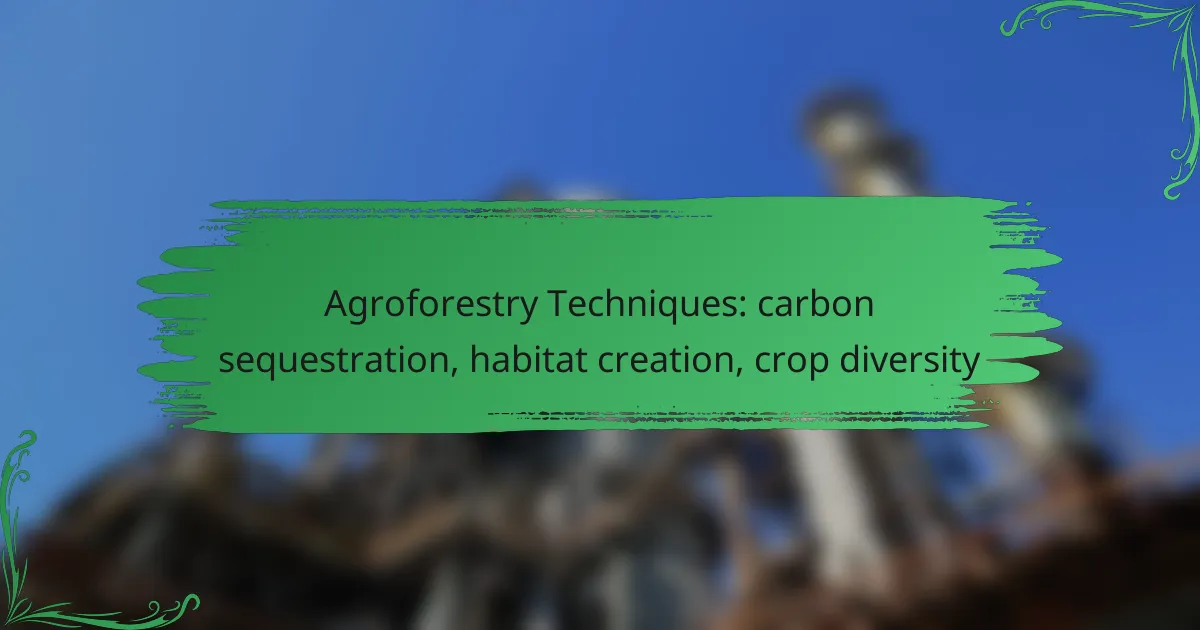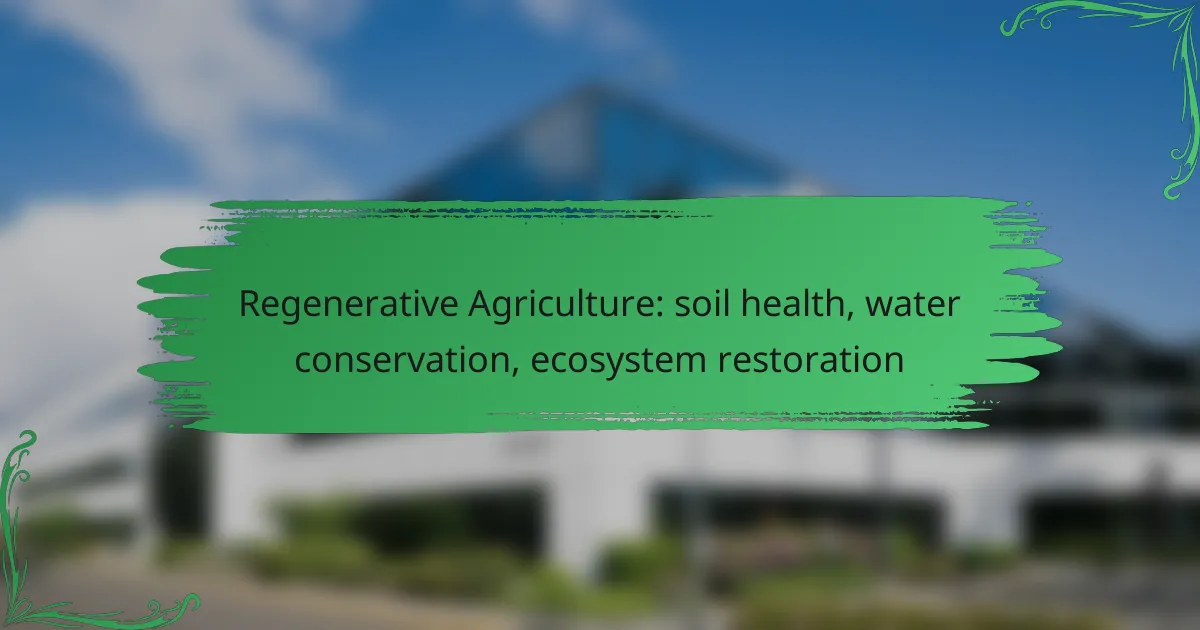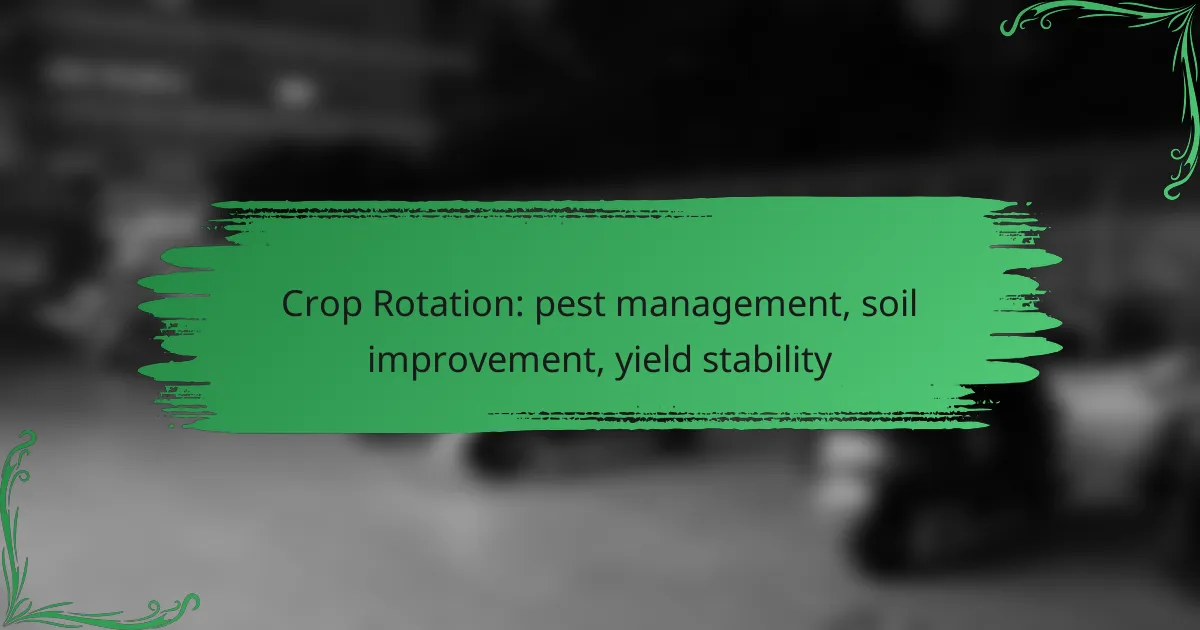Agroforestry techniques play a crucial role in promoting carbon sequestration, habitat creation, and crop diversity. By integrating trees and shrubs into agricultural systems, these practices enhance soil health, support biodiversity, and improve the overall resilience of farming landscapes. This multifaceted approach not only captures carbon dioxide but also fosters a thriving ecosystem that benefits both wildlife and agricultural productivity.

How does agroforestry contribute to carbon sequestration?
Agroforestry significantly aids carbon sequestration by integrating trees and shrubs into agricultural landscapes, enhancing the soil’s ability to store carbon. This practice not only captures atmospheric carbon dioxide but also improves soil health and biodiversity.
Increased soil organic matter
Agroforestry practices boost soil organic matter through the addition of leaf litter and root biomass from trees. This organic matter enhances soil structure, increases moisture retention, and promotes microbial activity, all of which contribute to higher carbon storage in the soil. Farmers can expect improvements in soil fertility and crop yields as a result.
Incorporating cover crops and mulching can further enhance soil organic matter levels, creating a more resilient agricultural system. Regular soil testing can help monitor organic matter content and guide management practices.
Tree canopy effects
The tree canopy in agroforestry systems plays a crucial role in carbon sequestration by directly capturing carbon dioxide during photosynthesis. This canopy also provides shade, reducing soil temperature and evaporation rates, which can lead to increased moisture retention in the soil.
Different tree species can offer varying benefits; for instance, fast-growing species can sequester carbon more quickly, while slower-growing trees may provide long-term carbon storage. Selecting the right species based on local climate and soil conditions is essential for maximizing these benefits.
Long-term carbon storage
Agroforestry systems can provide long-term carbon storage through the establishment of perennial trees that sequester carbon over decades. This contrasts with annual crops, which typically release carbon back into the atmosphere after harvest. By maintaining a diverse range of trees, farmers can create a sustainable carbon sink.
To optimize long-term carbon storage, land managers should consider practices such as agroecological zoning and the use of agroforestry models that align with local environmental conditions. Regular assessments of carbon stocks can help track progress and inform future management decisions.

What are effective agroforestry techniques for habitat creation?
Effective agroforestry techniques for habitat creation include practices that integrate trees and shrubs with crops and livestock, enhancing biodiversity and ecosystem services. These methods provide shelter, food, and breeding grounds for various wildlife, while also improving soil health and carbon sequestration.
Silvopasture systems
Silvopasture combines forestry and grazing in a single system, allowing livestock to graze under a canopy of trees. This technique not only provides shade and shelter for animals but also enhances forage quality and biodiversity. Farmers can increase their land’s productivity while promoting habitat for birds and other wildlife.
When implementing silvopasture, consider the spacing of trees to ensure adequate sunlight reaches the pasture. A common practice is to maintain tree densities that allow for at least 30% sunlight penetration to the ground. Regularly monitor the health of both trees and livestock to ensure a balanced ecosystem.
Alley cropping
Alley cropping involves planting rows of trees or shrubs alongside crops, creating alleys that can be used for agricultural production. This technique helps improve soil fertility, reduce erosion, and provide habitat for beneficial insects and wildlife. The trees can also serve as windbreaks, protecting crops from harsh weather conditions.
For effective alley cropping, select tree species that complement the main crops and provide additional benefits, such as nitrogen fixation. Ensure that the trees are pruned regularly to prevent competition for sunlight and nutrients. A typical arrangement might feature trees spaced 10-15 meters apart, with crop rows in between.
Forest farming
Forest farming is the cultivation of high-value crops under the protection of a forest canopy. This method allows for the sustainable harvesting of non-timber products like mushrooms, herbs, and berries, while preserving the forest ecosystem. It creates a unique habitat for various species, promoting biodiversity.
When starting a forest farming operation, assess the existing forest structure and choose shade-tolerant crops that thrive in lower light conditions. Consider implementing a rotational harvest strategy to maintain forest health and productivity. Regular monitoring of soil moisture and nutrient levels is crucial for successful crop growth.

How does agroforestry enhance crop diversity?
Agroforestry enhances crop diversity by integrating trees and shrubs into agricultural landscapes, which supports a wider variety of crops. This approach not only improves soil health and resilience but also promotes beneficial interactions among different plant species.
Intercropping benefits
Intercropping involves growing two or more crops in proximity, which can lead to increased yields and reduced pest pressure. For example, pairing legumes with cereals can enhance nitrogen fixation, benefiting both crops. This method also helps in optimizing land use and improving overall biodiversity.
Farmers should consider the compatibility of crops when planning intercropping systems. Selecting plants with different growth habits or nutrient requirements can maximize resource utilization and minimize competition.
Crop rotation strategies
Crop rotation is the practice of alternating different crops in the same field across seasons, which enhances soil fertility and disrupts pest cycles. For instance, rotating deep-rooted crops with shallow-rooted ones can improve soil structure and nutrient availability.
Implementing a rotation plan that includes a mix of legumes, grains, and cover crops can lead to healthier soils and reduced reliance on chemical fertilizers. Farmers should aim for a rotation cycle that spans several years to fully realize the benefits.
Companion planting
Companion planting involves growing different plants together that can benefit each other, such as planting basil alongside tomatoes to deter pests. This technique can enhance crop yields and improve pest management without the need for synthetic pesticides.
When selecting companion plants, consider their growth habits and nutrient needs. Avoid planting species that compete for the same resources, and focus on those that can provide mutual benefits, such as attracting pollinators or repelling harmful insects.

What are the economic benefits of agroforestry in the United States?
Agroforestry offers several economic benefits for farmers in the United States, including increased income, reduced costs, and new market opportunities. By integrating trees and shrubs into agricultural landscapes, farmers can enhance productivity while diversifying their revenue streams.
Increased farm income
Agroforestry can significantly boost farm income by providing multiple sources of revenue. Farmers can grow timber, fruits, nuts, and other products alongside traditional crops, leading to higher overall yields. For instance, a farmer might combine corn with fruit trees, allowing for harvests from both systems.
Additionally, agroforestry practices can improve soil health, which may lead to better crop performance and increased profitability over time. This holistic approach can create a more resilient farming operation.
Cost savings on inputs
Implementing agroforestry can lead to substantial cost savings on agricultural inputs. Trees and shrubs can improve soil structure and fertility, reducing the need for chemical fertilizers and pesticides. This can lower overall operational costs significantly.
Moreover, the shade provided by trees can help conserve moisture in the soil, decreasing irrigation needs. Farmers may find that these savings contribute to a more sustainable and economically viable farming practice.
Market opportunities for diverse products
Agroforestry opens up new market opportunities by allowing farmers to produce a variety of products. This diversification can appeal to niche markets, such as organic produce or specialty timber, which often command higher prices. Farmers can tap into local farmers’ markets or online platforms to reach consumers directly.
Additionally, agroforestry systems can enhance biodiversity, making farms more attractive to consumers interested in sustainable practices. By marketing their diverse offerings, farmers can differentiate themselves in the marketplace and potentially increase their customer base.

What are the prerequisites for implementing agroforestry?
Implementing agroforestry requires careful planning and assessment of various factors that influence its success. Key prerequisites include site evaluation, soil health assessment, and community involvement to ensure sustainable practices and positive outcomes.
Site assessment criteria
Site assessment is crucial for determining the suitability of land for agroforestry. Factors such as climate, topography, and existing vegetation must be evaluated to identify the best practices for integration. For instance, areas with moderate rainfall and good sunlight exposure are typically ideal for diverse crop and tree combinations.
Additionally, consider the proximity to water sources and the potential for erosion. Conducting a thorough site analysis can help in selecting appropriate species that thrive in local conditions, ultimately enhancing productivity and ecological benefits.
Soil health evaluation
Soil health is a fundamental aspect of agroforestry, as it directly affects plant growth and ecosystem functionality. Evaluating soil composition, nutrient levels, and pH can guide the selection of suitable crops and trees. Regular soil testing is recommended to monitor changes and make necessary amendments.
Practices such as cover cropping and organic amendments can improve soil structure and fertility, promoting better carbon sequestration and biodiversity. Aim for a balanced nutrient profile to support both tree and crop growth, which can lead to increased yields over time.
Community engagement
Engaging the local community is essential for the successful implementation of agroforestry projects. Involving stakeholders in the planning process fosters ownership and ensures that the practices align with local needs and cultural values. Community workshops and discussions can facilitate knowledge sharing and collaboration.
Moreover, consider forming partnerships with local organizations or agricultural extension services to provide ongoing support and resources. Building a strong community network can enhance the sustainability and resilience of agroforestry systems, benefiting both the environment and local livelihoods.



